Glass
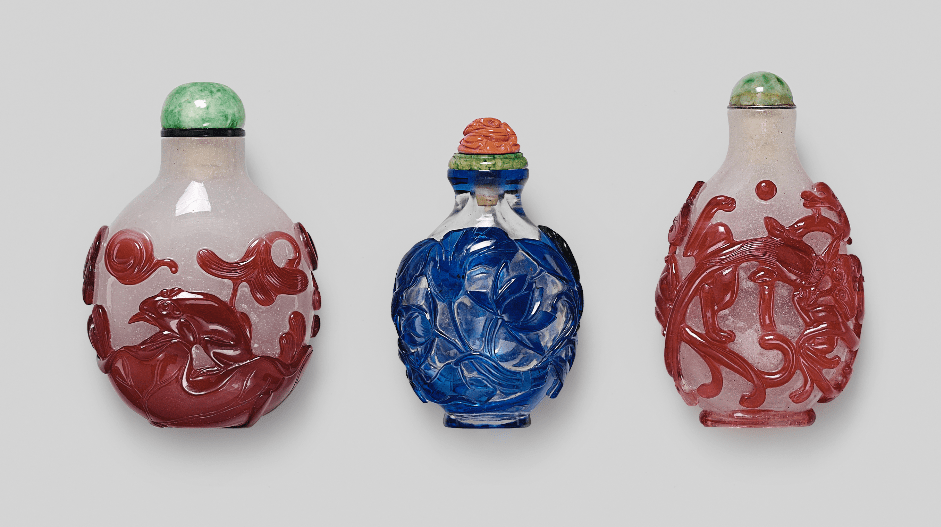
“Recently in the capital snuff has been produced. It is said to be able to improve one’s sight, especially to exorcise epidemic diseases. The snuff is put into glass bottles, which are of varying shapes, in colours of red, purple, yellow, white, black, green and brown. The white is clear as crystal, the red like fire. What lovely things they are! The spoon is made of ivory, used to extract the snuff out of the bottle to be inhaled, and then put back into the bottle. The snuff bottles are manufactured by the Imperial Court. Snuff bottles are also imitated among the people but are far inferior in quality and design.”
This statement, well known to all serious collectors of snuff bottles, was made by Wang Shizhen, a high-ranking minister of the Kangxi Emperor, in 1702. This is the earliest known reference to snuff bottles and confirms that glass was used for their manufacture ever since the introduction of snuff into China. Other materials may also have been used, of course, but it is obvious from this quotation that glass bottles, in a wide range of dazzling colours, were standard containers right from the beginning. The Chinese fascination with glass, both at Court and among the common people, continued throughout the entire snuff bottle period.
Jesuit missionaries at the Qing Court were vitally involved in early glass production; in fact, the Kangxi Emperor’s glasshouse was built near the Jesuits’ house, on land given to them by the Emperor. Their influence was therefore great, and they taught the Chinese artisans several glass techniques (the making of aventurine glass, for example) previously unknown to them. It would seem that after 1760, however, only Chinese glassmakers remained.
Although most glass bottles were blown, usually into a mould, many early bottles were carved from a solid piece of glass. The carving of glass blocks as if they were hardstones was a common alternative to blowing the vessels, and often reserved for glass imitating precious stones, such as aquamarine, amethyst and beryl. After the bottle was created, either by blowing or by carving, decoration could take any of several forms. Some, of course, were left plain to show off the beauty of their colour. Others were enamelled or engraved, both processes learned from the Europeans. Those made of cased or overlay glass would be carved and polished.
Jade
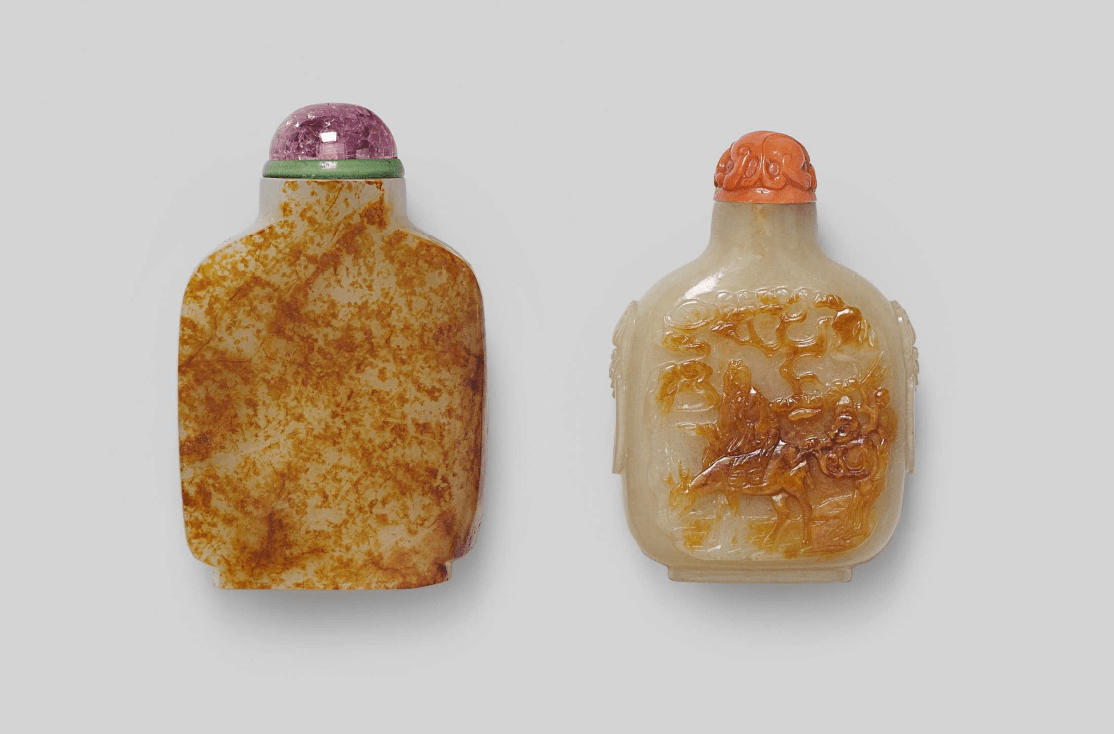
Jade is the quintessential Chinese stone and it has occupied a place of importance in China for several thousand years. Valued far above gold or precious stones, it is held not only in admiration and affection, but even in reverence by the Chinese.
Although nephrite and jadeite are both correctly called “jade”, they are actually two different minerals. Nephrite is usually of an opaque, creamy colour, and is most prized when it is pure white or yellow, although it is also found in other colours, ranging from pale grey to shades of green and black.
Nephrite has been worked by the Chinese from their very earliest recorded history, and it is the material from which most ancient jade artefacts were made. The main source for nephrite was the Kunlun Mountains which form the boundary between Chinese Turkestan and Tibet where it was traditionally found in riverbeds.
Jadeite is slightly harder than nephrite and tends to be translucent, with an icy, crystalline structure. Jadeite’s variety of colour is almost as great as that of nephrite but it is renowned for its apple-green and emerald-green tones which are of gem quality. It can also be found in shades of blue and lavender which are not found in nephrite. Although long considered a typically Chinese stone, no records have been discovered showing that jadeite is indigenous to China; it has been available to the Chinese only since the Qianlong period when it began to be imported from Burma.
Jade snuff bottles were made in the Palace Workshops in Beijing, as well as in other places involved in the production of jade carving. The best known was Suzhou, a southern town, long famous for the skill of its hardstone carvers.
Snuff bottles are usually between two and three inches tall and were meant to be held in the hand and examined closely. Jade seems to demand touching and tactile appreciation. The variety of colours, as well as the imperfections in the stone, provided inspiration to the craftsman, motivating him to create a masterpiece.
Hardstones
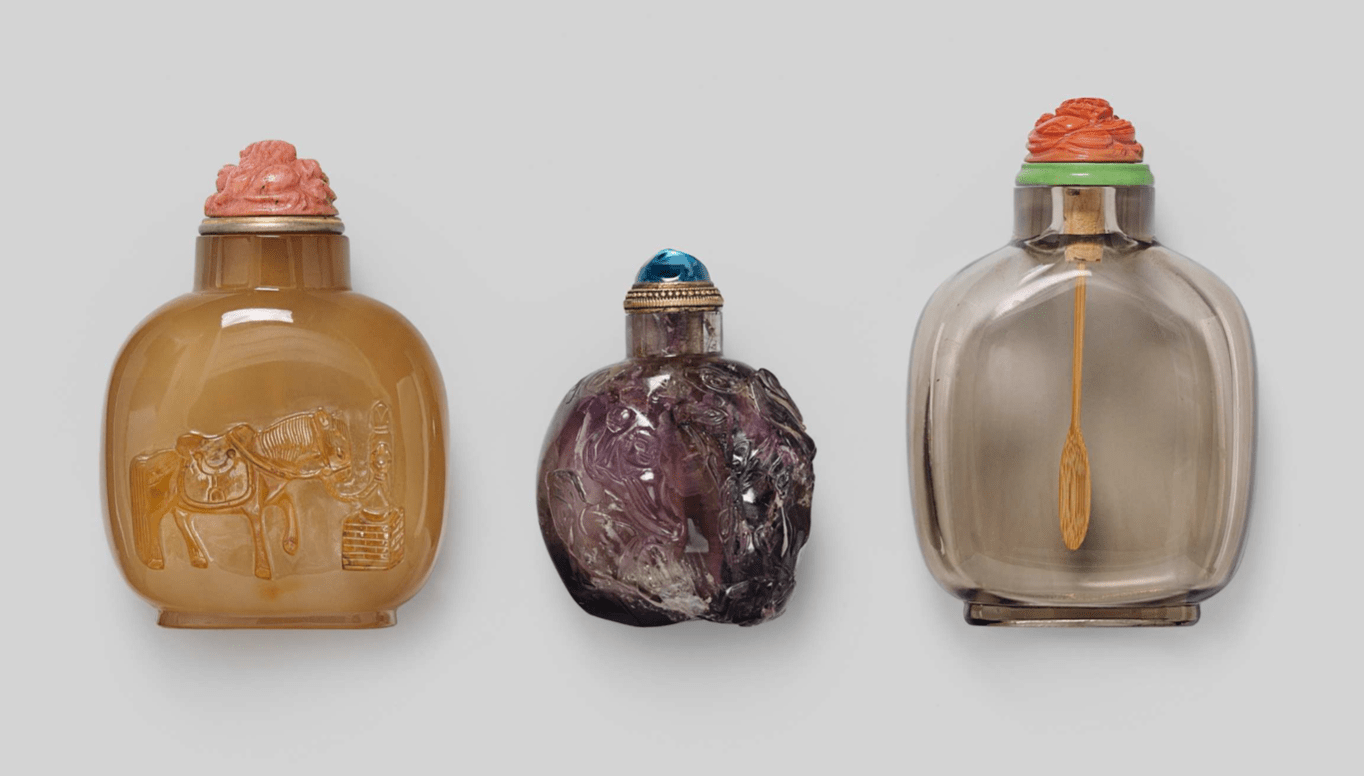
Quartz is one of the most common materials used to make snuff bottles. The quartz family is a very large one, and embraces a great many different stones. Crystal and chalcedony are the most obvious, but these can be further divided into several different types: agate, jasper, amethyst, citrine, carnelian, etc.
Because of the limitless range of colours to be found in the quartz family of stones, snuff bottle artisans were able to give free rein to their imaginations, often with amazing results. Maximum use was made of these distinctive markings in the stone. In many cases, this natural colouring was so striking that no further carving was required other than the actual forming of the bottle. The stone was left to speak for itself. When these bottles are beautifully made, perfect in line and form, superbly hollowed and with dynamic markings, they become exciting works of art.
Other bottles were decorated in “cameo” style: the top layer of colour was carved away to leave the design in relief against a ground of a different colour. Still others, known to collectors as “silhouette agates”, rely on the skill of the lapidary in selecting a piece of stone and cutting it in such a way that any natural inclusions suggest a design. Usually, a small amount of relief carving was needed to bring the design to completion. Bottles of this type, when carved by a master craftsman, are among the most dramatic of all snuff bottles.
Organics
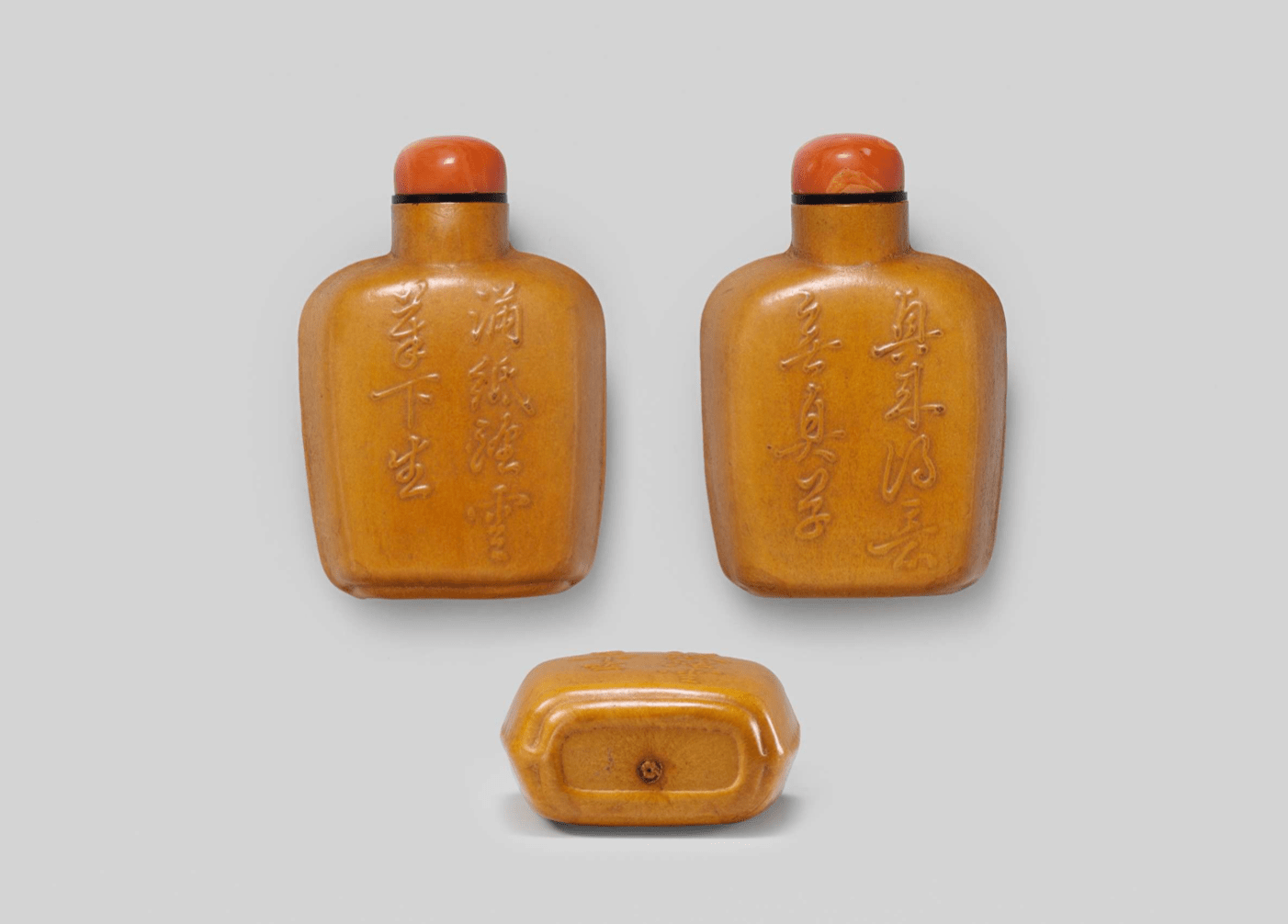
Many organic materials were used in the creation of snuff bottles, derived from animal and vegetable origins. Ivory was the most popular choice, carved into very intricate designs in relief. Others include amber, coral and bamboo. These snuff bottles are a reminder of the tactile nature of these objects as throughout their lifetime the oils of the hands create a glossy sheen, a process known as patination. Amber, gourd, and lacquered wood were also used.
Porcelain
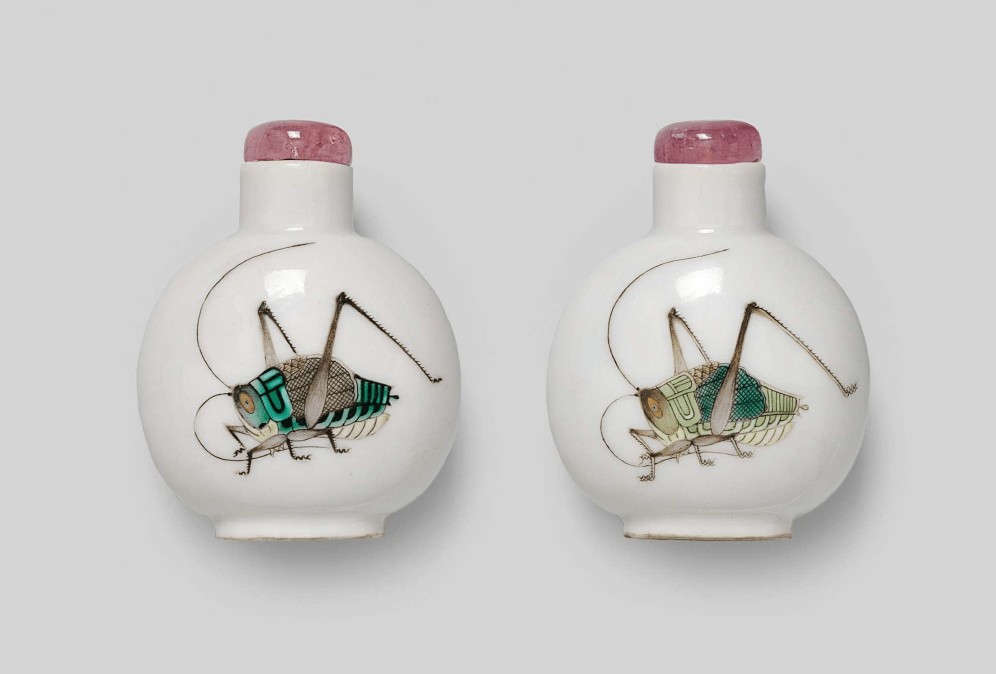
China is the birthplace of porcelain, and the ceramic arts have flourished more vigorously there than anywhere else in the world. It is therefore somewhat surprising that porcelain was not used by the Court for the manufacture of snuff bottles until near the end of the 18th century. This is possibly because neither of the two qualities for which porcelain was valued, its translucency and its sonority, was apparent in a small object like a snuff bottle.
Porcelain is composed of two basic raw materials: kaolin (known as china clay), and petuntse, a kind of feldspar which, when fired to a temperature of more than 1,280 degrees centigrade, produce a glassy and nonporous substance. Both these components were available in abundance around Jingdezhen, in Jiangxi province, and this town became the centre of porcelain production in China during the Ming and Qing Dynasties.
As the snuff-taking habit began to expand down the social scale from the exclusive Court and literati circles, the relative cheapness of porcelain made it a natural material for the vast numbers of snuff bottles needed for the use of the population at large, and production of porcelain bottles then increased enormously to meet the demand.
Porcelain snuff bottles can be simply moulded and enamelled, moulded with relief decoration and enamelled, carved and left unglazed or covered in glaze over the biscuit, or decorated in underglaze-blue or copper-red.
Perhaps the most familiar of all Chinese porcelain is that which is decorated in blue and white. In the long history of world ceramics, there has been no single ware more appreciated and imitated than Chinese blue and white porcelain – it is perhaps the best-known category of all decorative arts. Enormous numbers of blue and white porcelain snuff bottles were produced in the 19th century, and although it is rare to find one with a correct reign mark, many of these bottles are delightful.
The potteries at Yixing, famous since the Ming Dynasty for tea wares, also produced snuff bottles. The purple clay found in this area was thought to be the best for enhancing and retaining the colour, flavour and aroma of tea – and of snuff.
Inside Painted
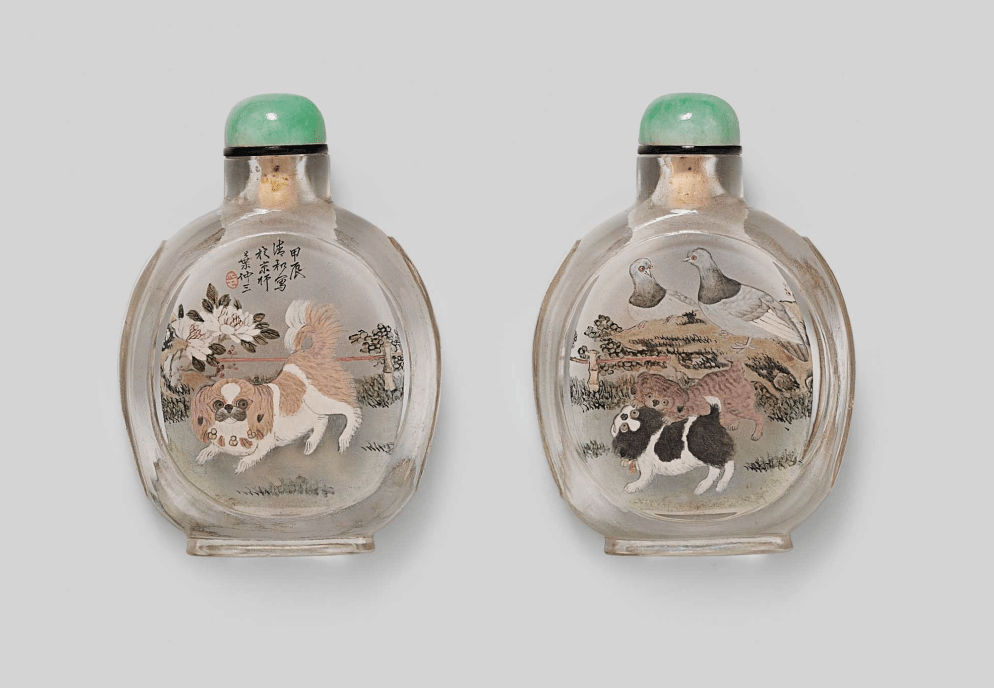
Inside painted snuff bottles, as the name suggests, are painted by using an angled brush inserted into the bottle, normally made of glass or a translucent hard stone. Although all snuff bottles require a high level of skill there is something about the seemingly impossible task of producing such delicate drawings that provides further interest. The majority of inside painted bottles date from the late 19th Century and many were never used to carry snuff, as wear and tear resulted in the loss of paint over time. They soon came to be appreciated solely for their artistic qualities.